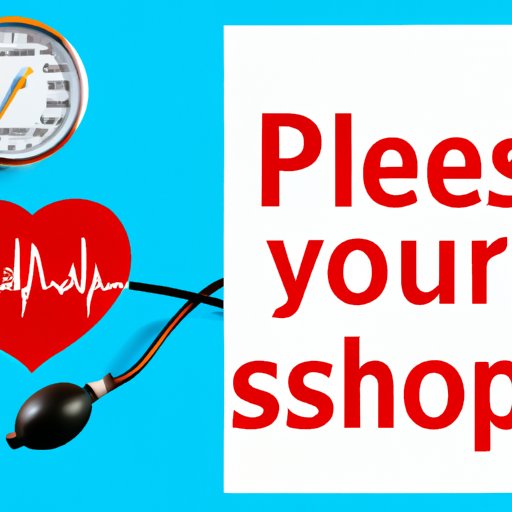
Introduction
Regularly monitoring your blood pressure is an essential part of maintaining good health. High blood pressure, also known as hypertension, can lead to serious health problems such as heart disease, stroke, and kidney failure. Blood pressure is measured in two numbers: systolic pressure (the top number) and diastolic pressure (the bottom number). Systolic pressure is the pressure in your blood vessels when your heart beats, while diastolic pressure is the pressure in your blood vessels when your heart rests between beats.
How to Take a Blood Pressure Reading at Home
While you can have your blood pressure measured at a doctor’s office, it’s also important to take readings at home to get a better understanding of your blood pressure over time. Follow these steps to take an accurate reading:
1. Choose the Right Kind of Monitor
There are two types of blood pressure monitors: manual and automatic. Manual monitors are the traditional blood pressure cuffs that inflate with a bulb, while automatic monitors inflate cuffs with a button push. Both types can be accurate, but it’s essential to choose a monitor made for home use and validated by professional medical organizations.
2. Position the Cuff
Wrap the cuff around your upper arm, with the lower edge of the cuff at least one inch above your elbow. The cuff should fit snugly but not be too tight or too loose, and the tubing should be in line with your middle finger. Rest your arm on a table or armrest so that it’s level with your heart.
3. Interpret the Results
When you turn on the monitor, it will inflate the cuff and then record your blood pressure. Record both your systolic and diastolic numbers, as well as the date and time of the reading. While healthy blood pressure levels can vary by age, gender, and health status, a typical healthy reading is around 120/80.
Common Mistakes When Measuring Blood Pressure
Even when you take readings at home, it’s easy to make mistakes that can affect the accuracy of your readings. Common mistakes include:
1. Measuring at the Wrong Time of Day
It’s important to measure blood pressure at the same time each day, as readings can vary throughout the day. Avoid taking readings after eating or caffeine intake, as this can temporarily raise your blood pressure.
2. Failing to Sit Still While the Reading Is Taken
Before taking a reading, sit quietly for five minutes and relax. It’s essential not to talk or move your arms during the reading, as this can affect the accuracy of the results.
3. Not Following the Instructions for Their Specific Monitor
Each blood pressure monitor has its specific instructions, so it’s essential to read and follow the manufacturer’s instructions carefully. Failure to follow the instructions can lead to inaccurate readings.
Tips for Managing Blood Pressure Naturally
Maintaining healthy blood pressure is critical to your overall health and wellbeing. Here are some natural ways to manage blood pressure:
1. Avoiding Sodium-rich Foods
Eating a diet high in sodium can increase blood pressure levels. Try to limit your sodium intake by avoiding processed foods, fast food, and packaged snacks.
2. Getting Regular Exercise
Physical activity can help lower blood pressure levels. Aim for at least 30 minutes of moderate-intensity exercise most days of the week, such as brisk walking, jogging, or cycling.
3. Minimizing Stress
Stress can raise blood pressure levels, so finding ways to manage stress is essential. Try techniques such as meditation, yoga, or deep breathing exercises to help reduce stress levels.
Blood Pressure Medications
If lifestyle changes alone aren’t enough to manage your blood pressure, your doctor may prescribe medication. Here are some common blood pressure medications and how they work:
1. ACE Inhibitors
ACE inhibitors work by relaxing blood vessels and reducing the amount of water and salt in the body. This reduces blood pressure and makes it easier for the heart to pump blood throughout the body.
2. Beta Blockers
Beta blockers work by blocking the effects of adrenaline on the body, which slows down the heart rate and reduces blood pressure levels.
3. Diuretics
Diuretics work by increasing urine output, which reduces the amount of water and salt in the body. This, in turn, reduces blood pressure and takes the pressure off the heart.
Common Questions About Blood Pressure
Here are some common questions people have when it comes to blood pressure:
1. What to Do If You Have a High Reading
If you have a high reading, it’s essential to monitor your blood pressure regularly and make lifestyle changes, such as eating a healthy diet, getting regular exercise, and managing stress. Your doctor may also prescribe medication if necessary.
2. How Often You Should Check Your Blood Pressure
If you have high blood pressure, your doctor will likely recommend checking it at least once a day or more frequently. If you have normal blood pressure, it’s still a good idea to check it regularly, such as once a month or every few months.
Working With a Healthcare Provider
Working with a healthcare provider is essential for managing blood pressure. Your doctor can help you develop an individualized treatment plan, monitor your progress, and adjust your medication as needed. To find a healthcare provider, check with your insurance company, ask for recommendations from friends and family, or look for providers in your area online.
Conclusion
Regularly monitoring your blood pressure is essential for maintaining good health and preventing serious health problems. By taking readings at home and making lifestyle changes, such as eating a healthy diet, getting regular exercise, and managing stress, you can manage your blood pressure and take control of your health.





